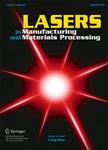版权所有:内蒙古大学图书馆 技术提供:维普资讯• 智图
内蒙古自治区呼和浩特市赛罕区大学西街235号 邮编: 010021

作者机构:Gazi Univ Dept Mech Technol Ankara Turkiye UCL Bartlett Sch Sustainable Construct London WC1E 6BT England King Fahd Univ Petr & Minerals Dept Mech Engn Dhahran 31261 Saudi Arabia Univ Oklahoma Data Sci & Analyt Inst Norman OK 73019 USA TU Wien Inst Chem Technol & Analyt Getreidemarkt 9 A-1060 Vienna Austria Missouri Univ Sci & Technol Intelligent Syst Ctr Rolla MO 65409 USA URTEMM Adv Mfg Technol Ctr Excellence Ankara Turkiye Addit Mfg Technol Applicat & Res Ctr EKTAM Ankara Turkiye
出 版 物:《LASERS IN MANUFACTURING AND MATERIALS PROCESSING》 (Lasermed. Imunopatol. Manuf. Mater. P. V.)
年 卷 期:2025年第12卷第1期
页 面:201-225页
核心收录:
学科分类:070207[理学-光学] 07[理学] 08[工学] 0805[工学-材料科学与工程(可授工学、理学学位)] 0802[工学-机械工程] 0803[工学-光学工程] 0702[理学-物理学]
基 金:European Union's Horizon 2020 research and innovation program under the Marie Sklodowska-Curie [101034425, A2M2TECH] Scientific and Technological Research Council of Tuerkiye (TUBITAK) [120C158] A2M2TECH project under the TUBITAK's 2236/B program
主 题:Conduction mode Thermocapillary Recoil pressure Ti6Al4V alloy Directed energy deposition
摘 要:Additive manufacturing (AM) has revolutionized many industries. Directed energy deposition (DED) offers remarkable utility in size and is an effective method in terms of energy efficiency. The interaction of powder with a laser before coming in contact with the substrate helps to attain fair melting and deposition. However, there is a problem associated with non-uniformity and accumulation of metallic melt on the edges of the manufactured parts which needs to be understood. Herein, the DED process of Ti6Al4V alloy is presented. The phenomenon of recoil pressure and Marangoni actions along the single tracks of the melt pool is defined via the computational fluid dynamics (CFD) analysis. The discrete element modeling (DEM) improves the simulation model output as variable particle diameters are considered, thus mimicking the actual powder size distribution. The simulation results disclosed intricate facts about the flow dynamics of molten material under varying conditions. The stream traces and thermal gradients are evaluated to recognize the effect of laser movement on material cooling and surface tension. The material accumulation occurred at curves and borders due to cooling-induced surface tension alterations, affecting the attribute of the deposited layers. The bi-directional flow patterns are prompted by Marangoni convection and recoil pressure, causing distinct features, including lateral menisci and depression modes. The cooling rates impacted the liquid portion and dilution levels, critical for attaining optimal bonding between deposited layers and substrate. Experimental endorsement using Synchrotron X-ray imaging favored the simulation results, confirming the simulated Marangoni convection effects. This comparison highlights the efficiency of CFD models in predicting molten material behavior, offering a worthy tool for adjusting DED printing parameters.